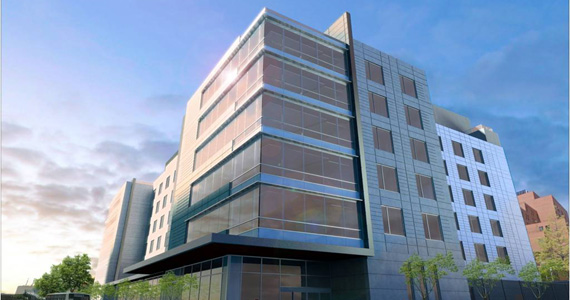

This article was co-written by Kent Doss, AIA, NCARB, LEED BD+C, LGB and Jon Sell, a Designer and Planner at Array Architects.
On the heels of our presentation on the Coler-Goldwater project process at the Center for Architecture for the NY AIA, we thought it might be worthwhile to identify a few of the key elements that allowed the design, buy-out and erection of the building envelope to facilitate an accelerated project schedule (these “keys for success” should hold true regardless of the project type or size and are listed in no particular order):
Limit the Number of Systems Required for Building Enclosure:
A critical factor in expediting the schedule is creating a climate controlled interior environment so that the tenant improvement work can commence as quickly as possible. One way to ensure that this important project milestone is reached quickly is to limit the number of different facade systems used in the exterior design. Reducing the number of different manufacturers and systems naturally leads to an expedited design, approval and erection process.
Evaluate Local Market Conditions for Procurement:
It doesn’t matter if you’ve chosen the most efficient and easily installed facade system if there are long lead times for its components to arrive on site. (Manufacturer proximity and transportation times can also be an important factor in this area).
Maximize Constructability and Speed of Installation:
Systems that allow for simple and effective panel and system joining details not only reduce documentation time-frames, but also speed up construction schedules.
Analyze Unitization and Prefabrication Possibilities:
Provided they do not adversely impact the material delivery schedules to the project site, unitizing and/or prefabricating components of the envelope can greatly increase construction efficiency.
Be Aware of Special Testing Requirements:
The designer should always be aware of any special testing that may be required by each system manufacturer for particular installation locations or system details (especially when different systems are combined in the factory – these can sometimes be different than the requirements for site installations). Since there is a real shortage of specialty testing facilities throughout the country, getting in line for testing can sometimes add significantly to delivery times (not to mention the added cost associated with these tests).
Make Systems Selections Early:
By determining the most appropriate and expeditious systems for a project as early as possible, the design team can focus energies towards developing these systems for optimal performance (cost, schedule, functionally and aesthetically).
Reconcile Systems and Budget Early (and Continuously):
Nothing slows the process more than a design that is not aligned with the project budget. Allocating valuable team resources to course correct budget problems puts the entire process at risk. Taking the time to build quantity and cost information into the BIM model early in the design process can help provide continuous budget oversight that allows the team to make forward progress. The IPD process can help facilitate this process as construction managers, subcontractors and manufacturers can join forces with the design team to integrate accurate cost information into the process.
Obviously, this isn’t a comprehensive list and every project will have its own unique challenges, but these can be used as a good starting point reference. While some of these items may seem limiting to the design of a building, we’ve found that transitioning as early as possible from a design exploratory mindset to a design optimization process can lead to a more thoroughly considered and executed design. The most basic and pedestrian materials and systems can be just as beautiful as the most exotic if properly applied and detailed for the specific project conditions.




